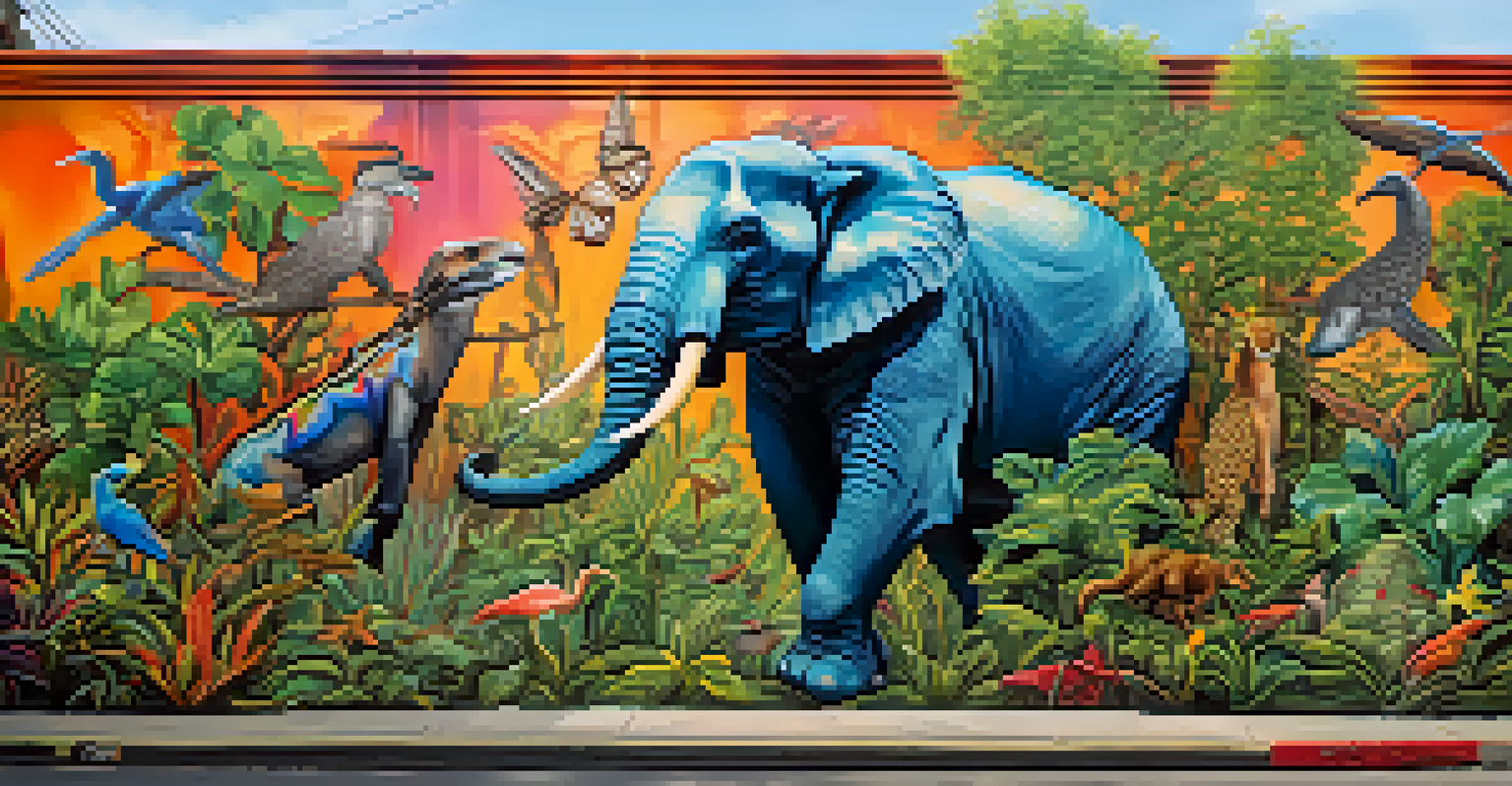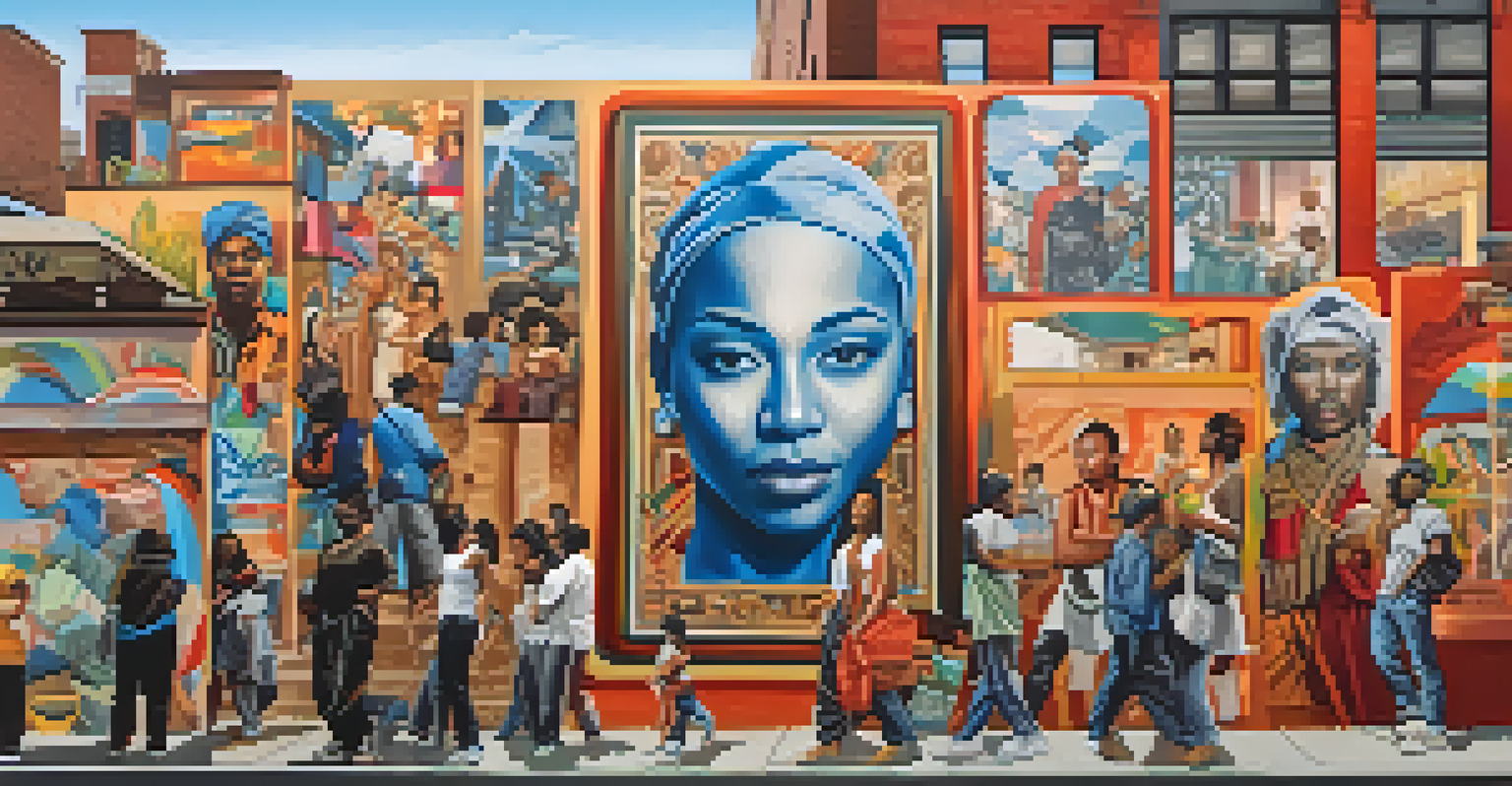Social Justice Messages in Street Art: A Global Perspective

The Evolution of Street Art as a Social Commentary
Street art has transformed from mere graffiti to a powerful form of social commentary. Over the years, artists have used walls as canvases to voice their opinions on pressing social issues. This evolution has made street art a vital part of urban culture, reflecting the community's struggles and triumphs.
Art is not a mirror to hold up to society, but a hammer with which to shape it.
For example, the rise of street art in the 1980s coincided with political movements, particularly in cities like New York and Paris. Artists like Jean-Michel Basquiat and Keith Haring used their art to address issues like race, inequality, and AIDS awareness. This connection between art and activism has only strengthened over the decades.
Today, street artists around the world continue to tackle topics like poverty, immigration, and environmental justice, making their work ever more relevant. The walls of cities have become a collective voice, echoing the desires and frustrations of marginalized communities.
Street Art as a Platform for Marginalized Voices
Street art serves as a potent platform for marginalized voices that often go unheard in mainstream media. Artists from underrepresented backgrounds use their creativity to share their stories and challenge societal norms. This has become especially important in regions facing political oppression or social unrest.

Take the example of the murals created during the Arab Spring in Egypt. These powerful images not only documented the struggle for democracy but also became symbols of hope and resistance. They enabled local artists to communicate their messages directly to the public, bypassing traditional media channels.
Street Art as Social Commentary
Street art has evolved into a significant medium for addressing pressing social issues, reflecting community struggles and triumphs.
By providing a voice to the voiceless, street art fosters a sense of belonging and community. It invites dialogue and encourages viewers to reflect on their own perspectives, making it an essential tool for social change.
Global Icons: Banksy and the Power of Anonymity
One of the most recognizable names in street art is Banksy, an artist known for his satirical and politically charged pieces. His anonymity adds a layer of intrigue, allowing his messages to stand at the forefront without the distraction of celebrity. Banksy’s work often critiques capitalism, war, and consumerism, resonating with audiences worldwide.
The role of the artist is to make the revolution irresistible.
For instance, his iconic piece, 'Girl with a Balloon,' has become a symbol of hope and loss, reflecting societal issues such as the refugee crisis. The simplicity of his art belies the complexity of the messages conveyed, proving that impactful communication can be both accessible and profound.
Banksy’s influence has paved the way for countless artists who wish to use their work for activism. His ability to blend humor with serious critiques has inspired a new generation to pick up spray cans and contribute to the conversation.
Street Art in the Fight for Gender Equality
Gender equality has become a prominent theme in street art, with many female artists leading the charge. They use their art to address issues such as violence against women, body positivity, and the fight for equal rights. Through vibrant murals and striking installations, these artists challenge stereotypes and inspire change.
A notable example is the work of Brazilian artist Panmela Castro, who combines art and activism to combat domestic violence. Her murals not only beautify urban spaces but also serve as a call to action, urging communities to stand against gender-based violence. This intersection of art and social justice helps raise awareness and fosters solidarity.
Empowering Marginalized Voices
Artists from underrepresented backgrounds utilize street art to share their stories and challenge societal norms, fostering community dialogue.
By amplifying women's voices through street art, artists are redefining narratives and encouraging dialogue around gender issues. This movement empowers individuals to take a stand and advocate for equality, making a significant impact on society.
Environmental Activism Through Street Art
Environmental issues have increasingly found their way onto the streets, with artists highlighting the urgency of climate change and sustainability. Street art serves as a powerful tool for environmental activism, capturing attention in a way that traditional media often struggles to achieve. Through striking visuals, artists can convey complex environmental messages with immediacy.
For instance, the work of artists like Eduardo Kobra emphasizes the beauty of nature while calling for its preservation. Kobra's colorful murals often depict endangered species and lush landscapes, reminding viewers of what is at stake. This approach not only raises awareness but also inspires action within communities.
By integrating environmental themes into their artwork, street artists encourage people to reflect on their relationship with the planet. Their creations spark conversations and motivate individuals to take personal responsibility for environmental stewardship, contributing to a larger movement for change.
Cultural Identity and Street Art
Street art often serves as a celebration of cultural identity, allowing artists to express their heritage and community pride. Through visual storytelling, these artists can convey their unique experiences and perspectives. This cultural representation fosters a sense of belonging and strengthens community ties.
For example, in cities with rich immigrant populations, street art can reflect the diverse backgrounds and stories of its residents. Murals that depict cultural symbols or historical figures help preserve the narrative of these communities. These artworks become a source of pride and a reminder of shared history, making them integral to the urban landscape.
Cultural Identity Celebrated
Street art serves as a vibrant expression of cultural identity, helping to preserve community narratives and promote inclusion.
By embracing cultural identity through street art, artists create spaces that honor diversity and promote inclusion. This not only enriches the community but also educates those outside it about different cultures, fostering understanding and empathy.
The Future of Street Art and Social Justice
As society continues to evolve, so too will the themes captured in street art. The medium's adaptability makes it an ideal vehicle for emerging social justice movements. Whether addressing new technologies, global health crises, or systemic inequalities, street artists will undoubtedly rise to the occasion.
Moreover, the increasing recognition of street art as a legitimate form of artistic expression will likely drive more artists to engage in social activism. With platforms like social media amplifying their reach, artists can connect with broader audiences and inspire collective action. This interconnectedness will foster a global community of artists united by a common purpose.

Ultimately, the future of street art in social justice is bright. As long as there are voices that need to be heard, artists will find innovative ways to share their messages, ensuring that the walls of our cities remain a canvas for change.